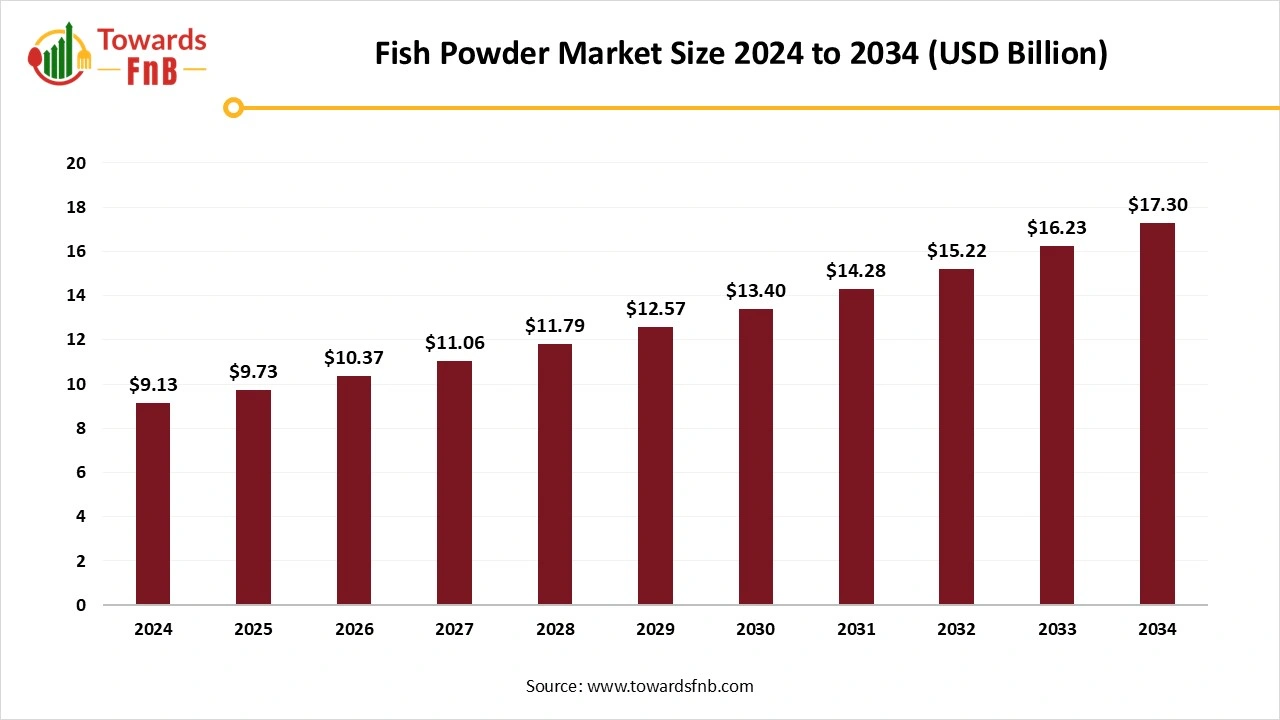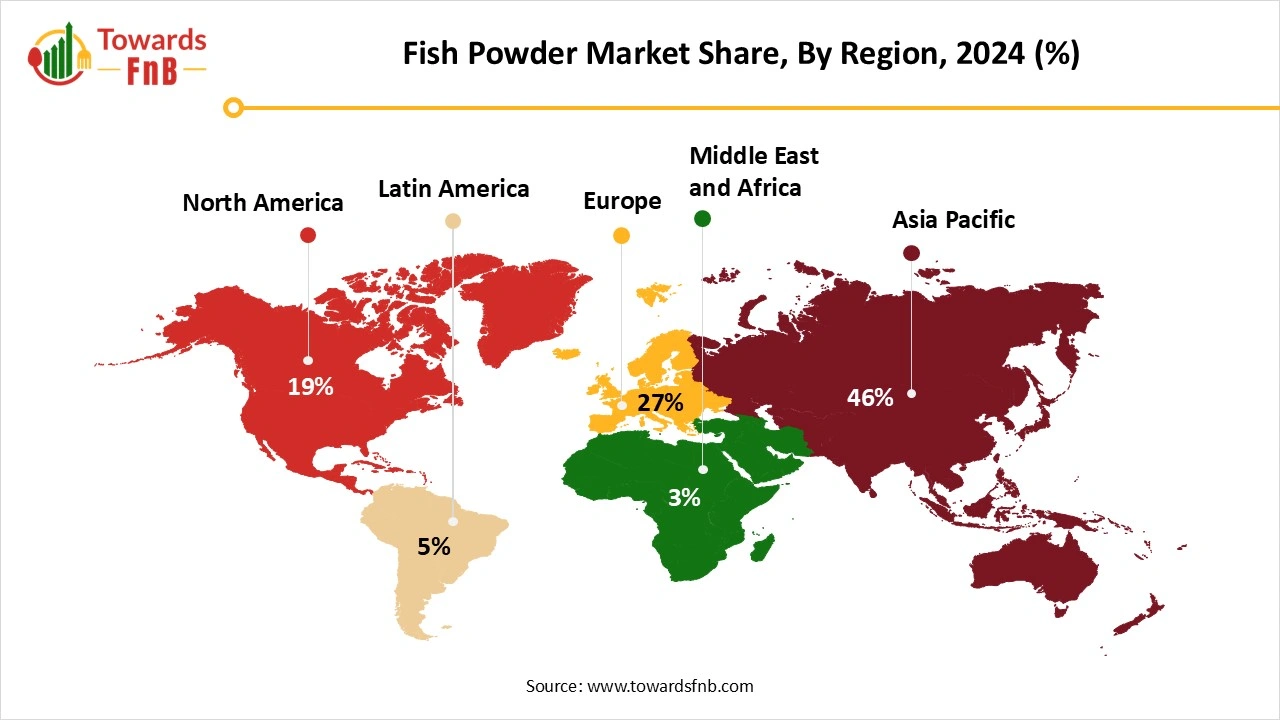April 2025
The fish powder market size was valued at USD 9.13 billion in 2024 is forecast to grow from USD 9.73 billion in 2025 to USD 17.3 billion by 2034, with a CAGR of 6.60% during the forecast period from 2025 to 2034. The growth is in the aquaculture and fisheries sector, the compulsion for food sources that are both sustainable and eco-friendly, and the rising demand for fish powder in animal feed and pet food industries.

Fish powder is made from the remaining fish, which can be utilized to enhance staple foods such as maize and cassava and, hence, improve levels of micronutrients in the diet. It is obtained by completely drying the fish or fish trimmings and then grinding them.
One of the market drivers for fish powder is the rising usage of fish powder for enhancing flavor and as a natural source of umami which is a shift towards categorizing waste reduction and maximizing fish by-products, demand for omega-3 fatty acid and main micronutrients, expanding the use of fish powder in cosmetic and personal care items which contribute in the expansion of the fish powder market.
Drying is one of the significant processes for the stabilization and preservation of food products which also emerging as the growth opportunity for the fish powder market. The goal of drying in most cases is to expand the shelf life by lowering the water content and the water. On the other hand, the product structure and appearance will be defined by the drying process. Marine products are extremely sensitive to high temperatures because of protein degradation and lipid oxidation.
Dried powders made from fish protein are being examined and tested as ingredients in bakery and snack products as sensorial testing of products has shown their characteristics in terms of aroma, bitterness, saltiness, and sour taste, which is linked with a concentration of marine powder in the baking flour. So, this fish powder can act as an insightful addition to the human food chain. The additives to bakery food products, such as powders, can be utilized as crucial ingredients in making noodles and pasta products, dairy products, and instant soups, or they can be used directly as nutritional supplements.
On the other hand, sustainable aquaculture will be a part of an ocean conservation plan. It diminishes the pressure on wild fish stocks and serves alternative seafood, hence safeguarding marine biodiversity, which prevents damage to necessary habitats like coral reefs and mangroves. For farm fish and seaweed, there is a positive effect as they clear the water quality by removing the pollutants and excess nutrients that could cause issues for other marine species living in their surroundings.
Climate change is having a notable effect on fisheries and aquaculture with growing ocean temperatures and an acidification factor, which affects the health and productivity of seafood species. Supply chain disturbances and industry metamorphose with more continuous and many weather events affect seafood production and trade. Overfishing and illegal, unnamed, and irregular fishing are also significant challenges that possess in the growth of the fish powder market.
Asia Pacific Held the Dominating Share in Fish Powder Market in 2024.
Asia’s rapidly growing population is experiencing many to accept a healthy brain which is crucial for a healthy body if they want to stay fit in life. Also, there is constant demand for plant-based applications, together with rising interest in omega-3, which signals a window of opportunity for food, beverage, and supplement manufacturers to grow algal DHA solutions. There are advances in microencapsulation technology, which is important in assisting formulators to go forward and grow plant-based omega-3 servings with superior experience. We should invest in small-scale fisheries by implementing measures to reduce bycatch and protect endangered species such as sharks, turtles, and dolphins.
Also, it emboldens the acceptance of sustainable fishing practices that do not harm the marine ecosystem or deplete fish stocks. Coastal communities also support small-scale and artisanal fisheries, which utilize sustainable methods and play an important role in local food security. Elevating awareness about the importance of selecting sustainable seafood and informing consumers about the environmental and social impact of their choices.

Latin America Expects Significant Growth in the Fish Powder Market During the Forecast Period.
There are several rising trends of Fish powder in Latin America as its usage in functional foods products such as protein bars, smoothies, and health drinks give importance to addressing consumer demand for high protein and nutrient-filled foods. Manufacturers are even offering customized fish powder to meet the urges of several end-user requirements, such as tailored protein levels for livestock feed or growth nutrient profiles for dietary supplements. Another trend is the acceptance of biodegradable and recyclable packaging materials, which is becoming a priority for manufacturers meeting consumer demand for sustainable packaging options. Fish powder is also gaining attention as a natural and organic fertilizer because of its nutrient-rich composition, which makes soil healthy and promotes plant growth.
The Whole Fish Segment Held the Dominating Share of the Fish Powder Market in 2024.
Whole fish provide a comprehensive nutritional package, including high quantities of protein, omega-3 fatty acids, amino acids, and minerals such as calcium, iron, phosphorus, and vitamins D and B12. These nutrients are found not just in the flesh but also in the bones, organs, and skin, making the whole fish beneficial in powdered form. Using the entire fish increases the uniformity and quality of the finished product, which is significant in both the food and feed industries.
The by-product segment is expected to grow at the fastest rate in the fish powder market during the forecast period. The growing demand for sustainable and economical protein sources, notably in aquaculture and livestock feed, has boosted the popularity of byproduct-based fish powder. Using by-products also contributes to global sustainability goals by reducing waste and increasing resource efficiency in the seafood supply chain. In areas with extensive fish processing industries, employing by-products reduces the environmental effect while increasing economic value to what was previously thrown away. As a result, fish by-products have progressed from being discarded materials to a valuable and widely accepted source of fish powder production.
The Swine Segment Held the Dominating Share of the Fish Powder Market in 2024.
The swine segment has expanded because of its high nutritional value, digestibility, and beneficial effect on pig growth performance and overall health. Fish powder, whether obtained from whole fish or by-products, contains high-quality protein, necessary amino acids, and omega-3 fatty acids, all of which are essential for swine development, particularly during early growth phases like weaning. Piglets are stressed during the weaning stage and have weak digestive systems; thus, highly digestible and appealing protein sources such as fish powder are suitable.
The poultry segment is expected to grow at the fastest rate in the fish powder market during the forecast period. Fish powder is a viable alternative to traditional protein sources such as soybean meal or meat and bone meal, especially in areas where fish byproducts are abundantly available. Its use is consistent with the industry's goals of increasing production while controlling feed prices and environmental issues. As the global poultry industry grows, there is a greater demand for efficient and nutrient-rich feed components, which has led to an increase in the use of fish powder.
MiAlgae
Z Natural Foods
By Source
By Application
By Region
April 2025
April 2025
April 2025
April 2025